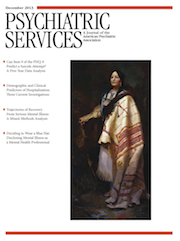SAMHSA Releases Behavioral Health, United States, 2012
Every two years since 1980 the federal government (the Substance Abuse and Mental Health Services Administration since 1992) has published Mental Health, United States. By adding data on substance abuse and its treatment, the latest volume—Behavioral Health, United States, 2012—increases the scope of the report and strengthens its utility as a resource for decision making in a changing health care landscape. The report’s extensive data on service utilization provides a baseline for assessing the impact of health care reform in the coming years. The latest volume also addresses some data gaps identified in previous reports by including improved data on children; military personnel, veterans, and military families; Medicaid beneficiaries; and the behavioral health treatment workforce.
The 388-page publication, which includes 172 tables, begins by highlighting current estimates based on data compiled from dozens of sources. In 2011, more than 41 million U.S. adults (18%) had any mental illness, and nearly 20 million (8%) had a substance use disorder. Nearly 9 million U.S. adults (4%) had a mental illness that greatly affected day-to-day living or caused serious functional impairment. More than one in eight U.S. adults received some type of mental health treatment in the past year, and two-thirds of adults with serious functional impairment received treatment. Almost half of U.S. children aged four to 11 with emotional or behavioral difficulties used mental health services at least once during the past year.
The Affordable Care Act (ACA) will greatly expand the number of insured Americans. Estimates in the report are intended to help policy makers and others assess the nation’s treatment capacity and make decisions about how best to expand it. For example, for every 100,000 persons in the U.S. population in 2011, the report estimates that there were 11.0 psychiatrists, 30.7 psychologists, 62 clinical social workers, 4.5 psychiatric nurses, 46.4 counselors, and 20.0 marriage and family therapists. The report estimates that there were 15.4 substance abuse counselors per 100,0000 population in 2011 and notes that national data are available for only a small number of the many types of staff providing substance abuse services. A total of 10,374 specialty mental health treatment facilities were operating in the United States in 2010 and 13,339 specialty substance abuse treatment facilities. Between 1998 and 2007, the number of community health centers—an extensive network of clinics in underserved areas—increased by almost 50%. By 2007, nearly 80% of these clinics had some specialty mental health services on site, and more than 50% had specialty substance abuse services on site.
The report also provides estimates on payers and payment mechanisms. Although expenditures on mental health care have increased in the past two decades (from $75 billion in 1990 to $155 billion in 2009), they have fallen as a share of all health expenditures. In 2009, prescription medication accounted for 29% of mental health spending but less than 4% of substance abuse spending. Publicly funded sources account for approximately 60% of mental health spending and 69% of substance abuse spending. Medicaid’s share of spending on mental health represents 30% of all spending in this area—a far higher share than that accounted for by Medicaid spending on all health in general (about 16%).
The new report provides expanded data on behavioral health disorders among children, while acknowledging notable gaps in information about children younger than age six. No national study of behavioral health problems among young children has been conducted. Gathering accurate data on children require a large number of interviewers who are highly trained, the report notes, and the difficulty and expense of such surveys may explain the data gap. Similarly, the new data compiled and reported for vulnerable populations, such as people with behavioral health disorders in nursing homes, homeless shelters, and jails, reveal critical gaps in our knowledge of these populations.
Behavioral Health, United States, 2012, is available at www.samhsa.gov/data/2012BehavioralHealthUS/2012-BHUS.pdf.



